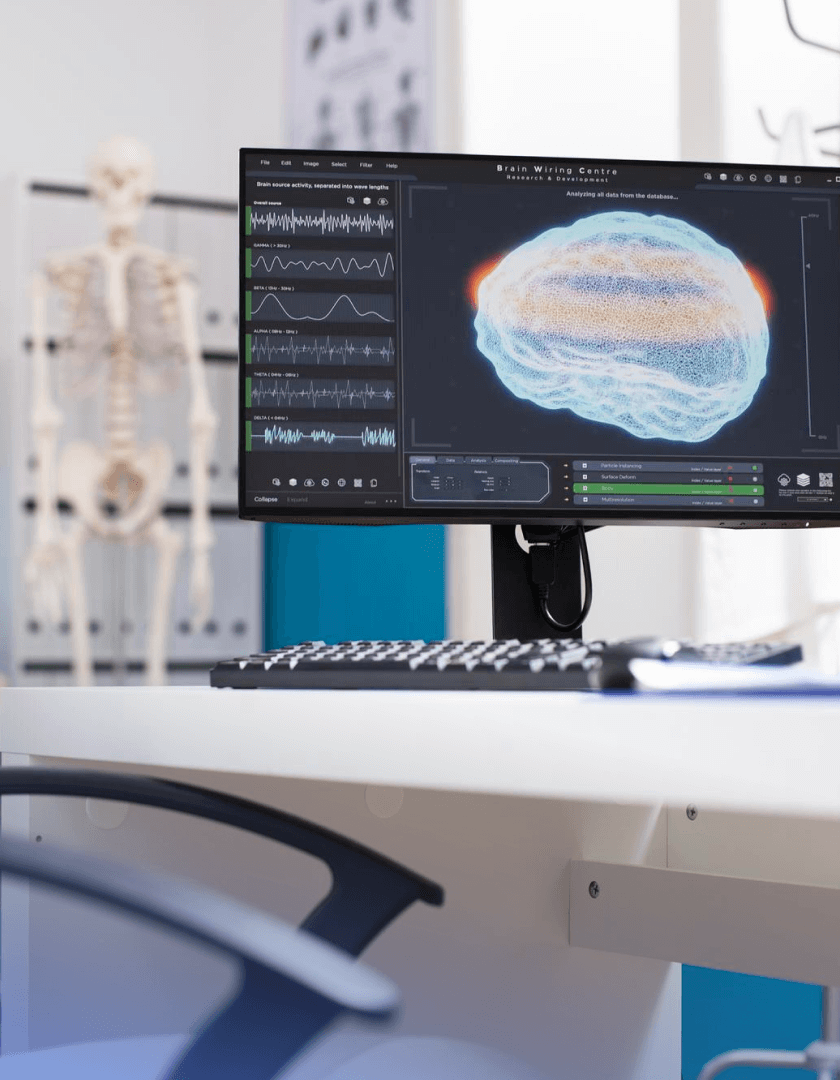
-
Client
The client is a behavioral health provider operating several clinics across the United States with a goal to make mental health care accessible and maintain a high standard of quality. They work with a wide range of patients, offering therapy, counseling, and psychiatric care in both urban and suburban areas.
Their day-to-day work is anchored in an EHR mental health system, a core part of their EHR healthcare operations. From documenting clinical encounters to managing schedules, the EHR is central to how the team delivers care. However, as the organization grew, the cracks in its technology setup became impossible to ignore. Staff were spending too much time on repetitive administrative work, clinicians were completing notes after hours, and the lack of system flexibility made implementing AI in healthcare an expensive challenge.
-
Business Challenge
The organization’s rapid growth created a widening gap between the volume of care they wanted to provide and what their systems could handle efficiently. As their needs evolved, it became clear they needed to address workflow gaps and explore how to improve interoperability in healthcare to ensure smooth data exchange across tools and teams. Strengthening clinical interoperability was also essential to connect disparate systems and reduce manual work.
Excessive After-Hours Documentation
Clinicians regularly worked 1.5 to 2 extra hours per day to finish SOAP notes, often late into the evening. This not only fueled burnout but also reduced the time available for professional development or rest.Manual Appointment Management
Staff handled scheduling, reminders, and follow-ups entirely by hand. This approach was time-consuming and contributed to high no-show rates, wasted slots, and last-minute schedule disruptions.Disconnected Operational Infrastructure
Billing and reporting were not linked to the EHR, forcing staff to manage them in separate systems. This added step increased the chance of errors, slowed work down, and sometimes resulted in denied insurance claims.Rigid and Closed EHR Platform
The EHR had no room for modular upgrades. Introducing automation or AI would have meant a costly rebuild and possible disruption to daily work.Compliance Concerns
Any new digital health app development in healthcare must meet strict HIPAA requirements. Leadership needed assurance that no changes would compromise security, privacy, or auditability.In short, the organization needed a way to modernize workflows, add AI capabilities, and integrate systems without the pain, cost, or risk of replacing their entire EHR.
-
Solution
Jelvix developed a modular clinical interoperability layer that connected the client’s EHR with new AI-powered workflows. This approach allowed the organization to bring automation into daily operations without altering the EHR’s core, avoiding costly disruptions and keeping the rollout smooth. The architecture was designed to be scalable, so additional behavioral AI features could be added in the future without major redevelopment.
Ambient AI for Documentation
Clinicians could dictate their notes during sessions, with speech captured and transcribed in real time. The system then organized the text into a structured SOAP format. This meant most documentation was completed before the patient left the room, reducing after-hours charting and improving accuracy while the details were still fresh.Conversational Bots for Scheduling
Automated communication tools took over the process of sending appointment confirmations, reminders, and follow-ups, delivering them through each patient’s preferred channel, like email, SMS, or the patient portal. The bots worked in real time, updating schedules and recording responses in the EHR. This automation added capabilities similar to a CRM healthcare software solution, improving patient engagement and reducing missed appointments.Predictive Analytics to Prevent No-Shows
The system used past appointment data to give each upcoming booking a risk score. When a slot was likely to be missed, staff were alerted in advance so they could reschedule or follow up. This made daily operations run more smoothly and helped more patients get care on time.FHIR-Ready API Integration Layer
A secure, standards-based middleware connected AI modules to the EHR without requiring invasive changes. By using FHIR protocols, the system could exchange data reliably and in real time, ensuring that both the AI tools and the EHR always had the most up-to-date information.Compliance-First Approach
Each part of the system included HIPAA protections, real-time logs, and the option to roll back changes. This allowed updates to be made without putting patient privacy or data at risk. Compliance was checked at every stage, so the system could grow while keeping trust intact.This setup enabled the client to launch a focused pilot, prove the value of AI for mental health, and then expand adoption across the organization at their own pace.
- Location
- USA
- INDUSTRY
- Healthcare, Behavioral and Mental Health
- SERVICES
- Custom EHR Integration, AI-Powered Workflow Automation, Compliance-Ready Software Development
- TECHNOLOGIES
- FHIR, NLP, Voice-to-Text AI, Predictive Analytics, API-Based Microservices, HIPAA Compliance Tooling
Product Overview
Client’s goals
The client aimed to make clinical documentation faster, lower the number of missed appointments, and improve overall operational efficiency. They wanted these changes implemented without disrupting existing workflows or compromising compliance standards. A major focus was on introducing AI capabilities that would enhance scheduling, documentation, and data handling.
One of their key goals was to prove that well-planned AI software development could deliver measurable results within the first 90 days, giving leadership the confidence to scale the solution across all clinic locations.

Implementation
The project started with a two-week discovery phase. Jelvix’s team mapped the client’s existing workflows, identified bottlenecks, and assessed integration points. The compliance officer conducted a full HIPAA review to ensure new features would meet all regulations.
The engineering team then developed a modular, FHIR-compatible integration layer. Ambient AI and NLP components were built to capture and structure SOAP notes during patient encounters. Predictive scheduling workflows and conversational bots were added, each with built-in audit and rollback features.
The solution was piloted with a select group of clinicians and administrators. Real-world feedback led to refinements in transcription accuracy, scheduling interfaces, and appointment risk scoring.
Value Delivered
Reduced Clinician Burnout Through Real-Time Documentation
With the ambient AI tool capturing and structuring SOAP notes during patient encounters, clinicians no longer had to spend one to two hours after their shift finishing charts. This freed up personal time, reduced stress, and helped improve work-life balance, which in turn supported better patient interactions the next day.
Significant Reduction in Administrative Scheduling Workload
Appointment confirmations, reminders, and follow-ups were shifted from manual processes to conversational AI bots. Staff could redirect several hours per week toward higher-value tasks, such as patient support and care coordination, rather than repetitive phone calls or email reminders.
Higher Patient Attendance and More Predictable Schedules
By scoring each appointment’s no-show risk, the system enabled proactive rescheduling. This meant fewer wasted time slots, steadier daily caseloads for clinicians, and better patient access to care.
Improved Billing Accuracy and Faster Revenue Cycles
Although not the primary project goal, the integration layer connected billing functions to the EHR. This reduced errors caused by manual data re-entry, decreased the number of denied claims, and accelerated payment processing.
Future-Proofed Technology Environment
The modular, API-first integration layer means the organization can introduce new AI capabilities without replacing its EHR or pausing operations. This positions them to adopt emerging healthcare technologies quickly and at a lower cost.

Project Results
The pilot rollout met the client’s goals and produced clear improvements across the organization in just three months. By pairing AI automation with a flexible integration layer, the solution eased daily workloads right away and demonstrated how AI in mental health can drive operational efficiency and better patient outcomes.
50% Reduction in After-Hours Documentation
With the ambient voice-to-text AI, clinicians could complete SOAP notes during sessions instead of writing them later. This cut after-hours charting from up to two hours a day to less than one, helping reduce burnout and freeing more time for patient care.
Noticeable Drop in No-Show Rates
Automated confirmations, reminders, and predictive rescheduling reduced missed appointments. High-risk bookings were flagged early, allowing staff to adjust schedules before a slot went unused.
Faster and More Accurate Billing
Connecting the EHR with the billing system automates invoice creation and reduces manual entry errors. This shortened payment cycles and lowered the number of denied claims.
Proven ROI within 90 Days
The pilot program delivered clear operational improvements like time savings for clinicians, fewer missed appointments, and better billing accuracy, meeting leadership’s target for early return on investment.
Scalable and Future-Ready Architecture
The modular, API-based integration layer now serves as a foundation for adding new AI features without replacing the EHR or disrupting existing workflows.

